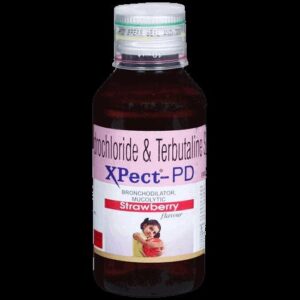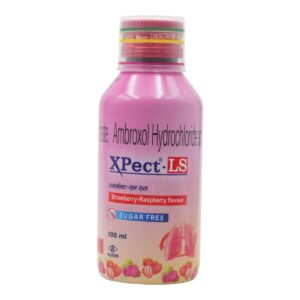AMBROXOL + GUAIPHENESIN + MENTHOL + TERBUTALINE
Ambroxol: Ambroxol is a medication that is primarily used for the treatment of respiratory problems associated with excessive mucus production, such as coughs, bronchitis, and respiratory tract infections. It is classified as a mucolytic agent, which means it helps to break down and thin mucus, making it easier to remove from the respiratory system.
The exact mechanism of action of Ambroxol is not fully understood. However, it is believed to work by increasing the production and secretion of pulmonary surfactant, which is a substance that helps to lubricate and protect the airways. Additionally, Ambroxol has been shown to stimulate the activity of cilia, hair-like structures in the respiratory tract that help to move mucus and foreign particles out of the lungs.
The usual dose of Ambroxol for adults is 30 mg to 60 mg taken three times daily. For children, the dosage is adjusted according to their body weight. Ambroxol is available in various formulations, including tablets, syrups, and oral drops, allowing for easy administration.
Like any medication, Ambroxol can cause side effects. The most commonly reported side effects include gastrointestinal disturbances such as nausea, vomiting, abdominal pain, and diarrhea. These side effects are usually mild and transient. Rarely, allergic reactions such as skin rashes or swelling of the face, tongue, or throat can occur. If any severe side effects are experienced, it is important to seek immediate medical attention.
It is important to note that Ambroxol should not be used without a healthcare professional’s advice, especially in certain medical conditions or in combination with other medications. Pregnant or breastfeeding women should consult their healthcare provider before using Ambroxol.
Overall, Ambroxol is a commonly used medication with a proven efficacy in the relief of respiratory conditions associated with excessive mucus production. However, it is always advisable to consult with a healthcare professional for the correct dosage and to discuss any potential risks or interactions with other medications.
Guaiphenesin: Guaiphenesin is an expectorant drug commonly used to relieve chest congestion caused by respiratory conditions such as the common cold, bronchitis, or allergies. It helps to thin and loosen mucus in the airways, making it easier to cough up and clear out.
The exact mechanism of action of guaiphenesin is not completely understood; however, it is believed to work by increasing the volume and reducing the viscosity of respiratory tract secretions. This promotes the clearance of mucus from the airways, leading to improved breathing and decreased congestion.
Guaiphenesin is available in various forms, including tablets, capsules, syrups, and extended-release tablets. The recommended dose for adults and children over 12 years of age is usually 200-400 mg every 4 hours, up to a maximum of 2400 mg per day. For children below 12 years old, the dose should be determined by a healthcare professional based on the child’s age and weight.
As with any medication, guaiphenesin can cause side effects. Common side effects may include dizziness, drowsiness, headache, nausea, vomiting, stomach upset, or rash. These side effects are generally mild and go away on their own. However, if they persist or worsen, it is advisable to consult a healthcare professional.
It’s important to note that while guaiphenesin can help relieve symptoms of chest congestion, it does not treat the underlying cause of the respiratory condition. If symptoms persist or worsen, or if new symptoms develop, it is important to seek medical advice for a proper diagnosis and appropriate treatment.
Menthol: Menthol, also known as peppermint camphor, is a naturally occurring compound derived from the peppermint plant. It is widely used in various pharmaceutical and consumer products due to its cooling and soothing effects.
Menthol is primarily used topically for its analgesic and cooling properties. It is commonly found in over-the-counter products such as topical pain relievers, cough drops, lip balms, and some topical creams and ointments. Menthol is also used as a flavoring agent in food and beverages.
The exact mechanism of action of menthol is not fully understood. However, when applied to the skin or mucous membranes, it produces a cooling sensation by activating TRPM8 receptors, which are involved in the perception of coldness. This activation leads to the desensitization of nerve receptors, providing temporary relief from pain and itching.
The dose and application of menthol vary depending on the specific product and intended use. For topical pain relief, menthol creams or gels are typically applied to the affected area three to four times daily. Menthol cough drops or lozenges can be used as needed for temporary relief of cough or sore throat symptoms.
Menthol is generally considered safe when used as directed. However, some individuals may experience mild side effects such as skin irritation, redness, or a burning sensation at the application site. In rare cases, allergic reactions may occur, characterized by hives, swelling, or difficulty breathing. It is important to discontinue use and seek medical attention if any severe side effects occur.
Though menthol is generally safe for topical use, it is not recommended for infants and children under the age of two due to the risk of potential adverse reactions. Additionally, it should not be applied to open wounds or broken skin.
Drug interactions with menthol are minimal due to its topical application. However, if using other topical medications or products, it is advised to consult a healthcare professional or pharmacist to ensure there are no potential interactions.
In summary, menthol is a widely used compound known for its cooling and analgesic effects. It is used in various topical products for pain relief and is generally safe when used as directed. However, individuals should be cautious of potential side effects and consult a healthcare professional if any concerns arise.
Terbutaline: Terbutaline is a medication primarily used to treat asthma, wheezing, and other breathing difficulties. It belongs to a class of drugs called beta-adrenergic agonists, specifically beta-2 adrenergic agonists. Terbutaline works by relaxing the smooth muscles in the airways, allowing for easier breathing.
The drug can be administered orally, through an inhaler, or by injection. The appropriate dose and route of administration depend on the individual’s condition and age. Generally, for asthma treatment in adults, a typical oral dose is 2.5 to 5 mg every 6 to 8 hours. In children, the dose may be lower and adjusted according to their age and weight.
Terbutaline can have various side effects, including increased heart rate, palpitations, tremors, headache, nausea, vomiting, dizziness, and nervousness. These effects are mostly mild and transient. However, higher doses or prolonged use can increase the risk of more serious side effects such as chest pain, irregular heartbeat, hypertension, muscle cramps, and difficulty sleeping. In rare cases, terbutaline may cause allergic reactions, characterized by rash, itching, swelling, or breathing difficulties.
It is essential to follow the prescribed dosage and usage instructions provided by the healthcare professional. Terbutaline should not be used as a rescue medication for sudden asthma attacks; instead, a quick-acting inhaler should be used for immediate relief. It’s important to consult a healthcare provider for proper evaluation and management of asthma or any respiratory condition before using terbutaline or any other medication.


